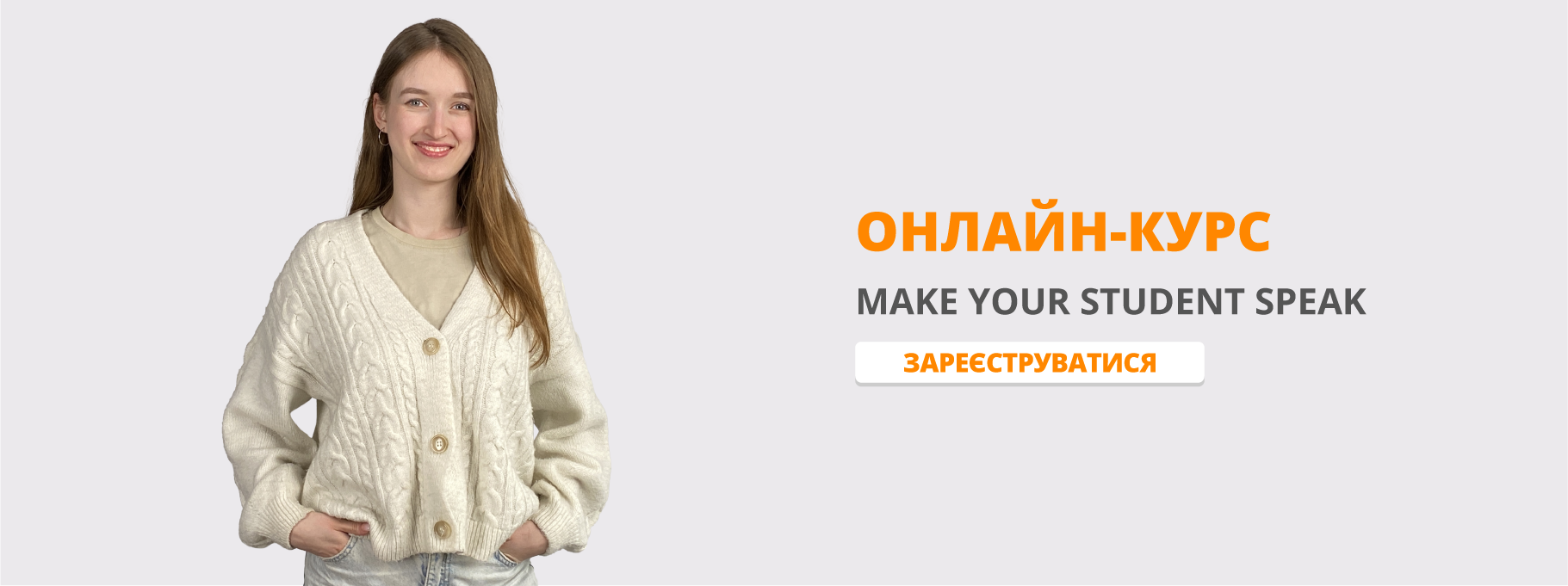Урок на тему : "My Motherland"
Practical:
to develop communicative skills using active lexiс on the topic; to develop their fluency in using the language; to get them to know . how to use the existing knowledge.
Educative:
To focus pupils' attention on specific words and word combinations; to encourage them to guess meanings of new words from the context using pictures.
Social:
To cultivate love for our Motherland, to teach children to respect their native country, to love their native town.
Materials needed:
The motto on the blackboard;
Proverbs;
embroided towels on the board (embroided shirt, blouse . . . identifying symbols of Ukraine);
text for reading; cards for matching.
Урок “My Motherland”
6 клас, за підручником О. Карп’юк
Motto “He, who loves not his
Motherland can love nothing” G.Byron
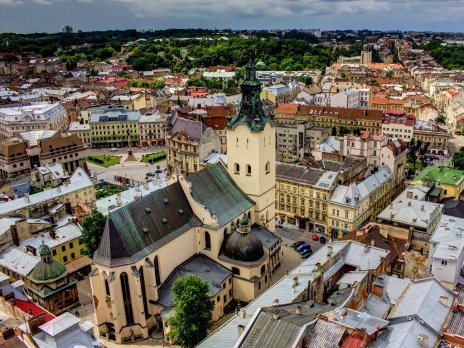
Objectives:
Practical:
to develop communicative skills using active lexiс on the topic; to develop their fluency in using the language; to get them to know . how to use the existing knowledge.
Educative:
To focus pupils’ attention on specific words and word combinations; to encourage them to guess meanings of new words from the context using pictures.
Social:
To cultivate love for our Motherland, to teach children to respect their native country, to love their native town.
Materials needed:
The motto on the blackboard;
Proverbs;
embroided towels on the board (embroided shirt, blouse . . . identifying symbols of Ukraine);
text for reading; cards for matching.
Procedure:
Introduction.
Teacher. Good morning, dear friends. I’m pleased to see you at our lesson. I hope you are fine and we’ll have wonderful minutes of communication. Children, look at the blackboard and try to formulate the topic of our lesson. (There are identifying symbol of the Ukrainian nation (embroided towel, shirt, blouse, coloured
ribbons ) and the motto).
Well, we have spoken a lot about Ukraine, its geographical
position, its people, traditions. But today we are going to speak about cities and towns of Ukraine and about the place, where
you were born and live in.
My dear friend,
I’d like to speak of land
In which you must defend
The slightest bend,
Where spreading is the steppe,
Where’s done the first your step,
Where mother’s shortest nap.
Was broken by your joyful clap.
a) Warming – up.
Teacher. Look at the blackboard and match the first part of the phrase to the second one to make up a proverb.
East or West . . . home is best
Every bird . . . like home
There is no place . . . likes its nest
Please, give Ukrainian equivalents of these proverbs.
b) Teacher.
Tell me, please what is Homeland (Motherland) for you; Let’s make the word-map.
![]()
![]() Ukraine Kyiv
Ukraine Kyiv
![]()
![]() Homeland
Homeland
L’viv Zolochiv
Teacher
Think and name some reasons for travelling to Ukraine



![]()
![]()
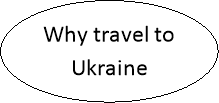
![]()


![]()
![]()
![]()



Start like this:
People travel to Ukraine . . .
(Pupils make up sentences)
Teacher O.K. There are many reasons for travelling to Ukraine, because our Homeland is very beautiful and people in Ukraine are very hospitable, aren’t they?
Pupils. Yes, they are.
Teacher.
Look at this word- map and say what kind of people are Ukrainians:
Start like this:
The Ukrainians are . . .
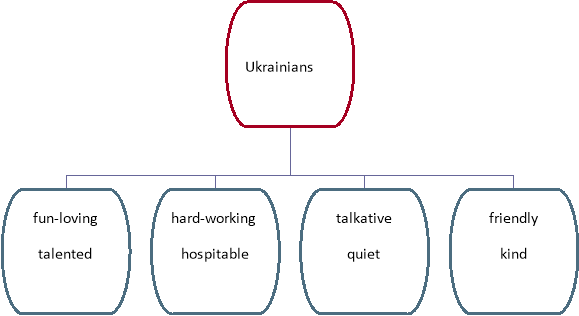
(Pupils make up sentences)
Teacher. Nice of you. Thank you. I am proud I am Ukrainian and you, Terry?
P1 So, am I.
P2 And so am I.
T. Thank you children.
So, the topic of our today’s lesson is Ukraine. Now, I propose you to read some Fact Files.
1. Ukraine is situated in the centre of Europe.
2. The capital of Ukraine is Kyiv.
3. The climate of Ukraine is continental.
4. The largest range of mountains is the Carpathians.
5. The highest peak is Hoverla.
6. The main rivers are the Buh, the Dnipro, the Danube and Dnister.
7. The longest river is the Dnipro.
8. The largest cities are Kyiv, Kharkiv, Dnipropetrovsk, Donetsk, Lviv.
9. Ukrainians are very hard-working and hospitable.
10. the national symbols of Ukraine are the flag, the Trident and the anthem.
Teacher.
And now I want you to ask each other questions about Ukraine.
Pupils of group II and III answer them.
Where is Ukraine situated?
What is the capital of Ukraine?
What is the climate of Ukraine?
What is the highest peak of Ukraine?
What is the longest river?
What are the largest cities?
What are the Ukrainians like?
What are the national symbols of Ukraine?
Teacher.
Thank you, children. I think, you are ready to do the following task.
Be very attentive and fill in the form. (writing) and be ready to introduce your country at the map of Ukraine.
Fill in the form:
|
Name |
|
|
Capital |
|
|
The highest peak |
|
|
The longest river |
|
|
The longest cities |
|
|
National symbols |
|
- Reading
Teacher:
I want you, children to know more information about national symbols of Ukraine.
Please, answer my questions, then read the text and say if statements below are true or false.
Answer the questions.
What are the nationals symbols of Ukraine?
What does our flag symbolise?
Who are the authors of the anthem?
Can you recite the Ukrainian version of the anthem?
Do you know how to behave while listening to the anthem?
National symbols of Ukraine
There are the main official symbols of Ukraine: emblem, flag and anthem.
Our national emblem is a golden trident on a blue background. The trident is a symbol of power. It’s about 1000 years old. It was depicted on the coins of Volodymyr the Great (979-1015), the Grand Prince of Kyiv.
Why was the trident chosen as the emblem of Ukraine? The three points of the trident symbolize the trinity of life: Father, Mother, Child. They symbolize Might, Wisdom and Love.
Besides, three is thought to be a magic number. We can find a lot of examples with this number in folk tales three epic heroes, three wishes, three roads.
Post-reading task
Say if these statements are true or false.
1. Our national symbol is a red star on a blue background.
2. The trident is a symbol of power.
3. The trident is a newly founded symbol.
4. The trident is about 1000 years old.
5. It was depicted on the cons of Volodymyr the Great.
6. The three points mean Love, Friendship and Success.
7. The number “three” is a magic number.
Listening
Teacher
Now listen to the text and guess what cities are mentioned in it.
1. It is very big and old. It is in Ukraine. It stands on the river. You can see beautiful, fine buildings, many museums and monuments, churches and hotels, large shops, institutes and schools, plants and factories there. The streets are long and the squares are big. The main street is Khreshchatyk.
2. This city is the ancient capital of Galychyna. It was named by its founder the King Danylo Galytsky, in honour of his son Lev. It is a great cultural centre of Ukraine, and it is so beautiful that it is often called “the Pearl of Europe”. There are many museums, churches, schools and universities. Many tourists visit Pharmacy Museum, Rynok Square and Svoboda Avenue.
3. It is not big town. But it is very beautiful. There are many ancient buildings in the centre of town. There are many churches, four schools, a college and a lyceum in it. There are monuments to M.Shashkevych, T.Shevchenko and V.Chornovil in town. The main Street is Shashkevych Street and the longest is Shevchenko Street.
T. Well done. Kyiv, Lviv, Zolochiv
Please, write city-names in column and give their identifying words
Kyiv – Khreshchatyk
L’viv – Galychyna, King Danylo Galytsky, Lev, Museum, Rynok Square and Svoboda Avenue.
Zolochiv – monuments to M.Shashkevych, T.Shevchenko and V.Chornovil, Shashkevych Street and Shevchenko Street.
Project works
Teacher.
Now its time to start your projects pupils are united into three groups:
They present Kyiv, L’viv, Zolochiv.
Children, you had gathered the material and made wonderful posters.
I think you are ready to start presentation.
Group I. Kyiv
A project starts with a poem.
a poet tells a poem
a speaker presents a story about Kyiv
a guide names the historical places of Kyiv.
Kyiv
I. Love your Ukraine
As you would the sun,
The wind and the springs together
Love her in happy hours
And in time of stormy weather
Любіть Україну, як сонце любіть
І вітер, і трави і води.
Любіть Україну у радості мить,
Любіть у хвилину негоди.
II. About Kyiv
Kyiv is the capital of Ukraine. It is one of the oldest cities in Europe. There are many places of historic interest in it. Among them are the Kyiv-Pechersk Lavra, the Golden Gate, the St. Sophia Cathedral and others. Kyiv stands on the river Dnipro. It is the longest river in Ukraine. Kyiv is very lovely. There are many parks and gardens in Kyiv. The population of Kyiv is about 3 million people. There are many museums, art galleries, theatres and cinemas in the capital. The central street of Kyiv is Khreshchatyck.
A lot of tourists visit Kyiv.
Group II. Lviv
a) poem.
b) a story.
c) Excursion about the city.
Lviv
Lviv is “The Pearl of Europe”
I. From the northern steppes
To southern shining sea,
From the western heart,
Lviv, you call to me.
II. Welcome to Lviv
Lviv is our regional centre. It is the most beautiful city of Western Ukraine. The city was founded by Danylo Halytskyi and named after his son Lev.
There are many historical places, monuments, museums, galleries, theatres and cinemas in Lviv.
Lviv is a very beautiful city. The Old City Hall stands in the centre of the Rynok square. You can visit Lviv Picture Gallery, the Opera and Ballet Theatre, Maria Zankovetska Ukrainian Drama Theatre, the Lviv Museum Ukrainian Park and other interesting places.
Group III. Zolochiv
a) poem.
b) a story.
c) Excursion about the town.
Zolochiv
I. Town of Zolochiv
Is the town of mine
Churches, schools
Are here, we know
Sunny and tidy
And happy all time
People are pleasant
Wherever you go
Містом йду і всміхаюсь я
То Батьківщина маленька моя.
II. Excursion about the town
Zolochiv is a beautiful town in Western Ukraine. Zolochiv is situated not far L’viv. The population of Zolochiv is about twenty thousand people. Our town was founded in 1427. It is one of the oldest towns in Western Ukraine. Zolochiv is famous for it’s castle which was built in 1671.
In the centre of our town is the Catholic Temple. There are six churches in Zolochiv. they are very beautiful.
There are many monuments in our town too. There is a monument to T.Shevchenko, to M.Shashkevych, and the monument to V.Chornovil, a political leader of Ukraine.
Our town is green and beautiful. There are many parks and squares in it. A lot of tourists visit our town. Welcome to Zolochiv.
Summarizing :
Teacher:
Thank you. You worked (well) hard and your projects are bright and interesting. You worked well because helped one another. I hope this group work will help you to be helpful, more organized and better disciplined. You all get good marks. I’ll name them after a song about Ukraine.
A song “ A page is white, the ink is black . . .”.
Home task:
Children, please open your diaries and write down the home task:
Read a Ukrainian folk tale “The Bear and the Bees” and answer the questions on the text.
Ex. 1, 2 p. II8.
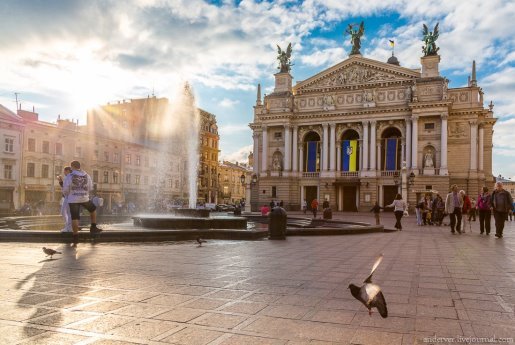
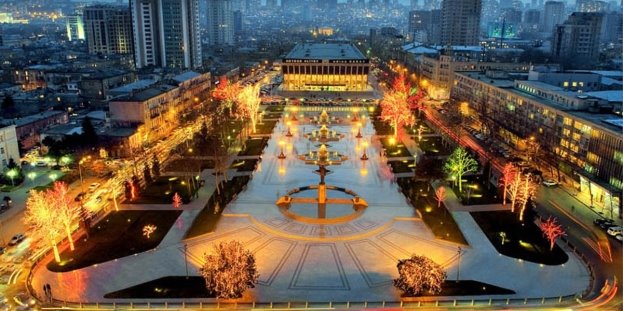


про публікацію авторської розробки
Додати розробку
